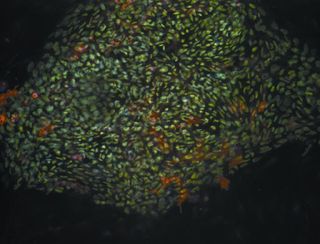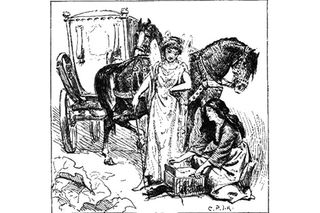Inside Life Science: Once Upon a Stem Cell
Once Upon a Stem Cell

This little stem cell became heart cells, this little stem cell made bone, this little stem cell had mutant genes, this little stem cell had none ... When stem cell research began a decade ago, its possibilities — from shedding light on early human development to replacing defective or diseased cells — seemed the stuff of a bedtime story.
But scientists supported by the National Institutes of Health are learning more and more about the basic biology of stem cells. They are pinpointing the unique properties and potential of each type: embryonic stem cells that can become just about any cell, adult stem cells that can become specialized tissue or organ cells, and induced pluripotent stem cells that are mature adult cells reprogrammed to act like embryonic ones.
Here are five findings that illustrate the substantial strides researchers have made in understanding all the stem cell characters and their future fates.
The Mark of Destiny

Up until a few years ago, scientists thought that genes specific to types of tissue were dormant until stem cells differentiated into heart, bone, skin or other kinds of cells. But then researchers at the University of California, Los Angeles, discovered that proteins mark these genes early on, during the pluripotent stage when cells have the potential for a wide range of future functions. The scientists now think that stem cells’ ability to differentiate into their different destinies may depend on the presence of these marks. The insight could help researchers better understand the nature of pluripotency and make sure that stem cells are fully functioning and competent to fulfill the desired destiny before being tested as treatments.
The Stiff, the Squishy, and the Hard to Stress

Not all stem cells start out the same: Like the houses of the Three Little Pigs, some seem to be built from straw and others from bricks. Scientists at Brown University determined that the physical properties of stem cells can predict the type of tissue for which the cells are most suited. They found that bone cells were best developed from stiff stem cells; that fat could most easily form from soft, squishy stem cells; and that cartilage cells could best be created from stem cells with a high viscosity—or resistance to tensile stress. For the distant future, the researchers envision stem cell retrieval, sorting and therapy occurring in the same procedure; surgeons repairing a bone could, for example, extract excess fat from the patient and choose the stiffest stem cells to inject at the surgical site.
A Concoction for Making Heart Cells

When Cinderella’s fairy godmother made a pumpkin into a carriage, she had to use the right spell. Similarly, to coax stem cells to form only the type of cells that they want, scientists have learned that it takes the right formula. Researchers at the McEwen Centre for Regenerative Medicine in Toronto, Canada, created a concoction of nutrients and proteins that spurred human embryonic stem cells to become heart progenitor cells, or adult heart cells in their beginning stages. Those cells then grew into the three different types that make up functioning heart muscle. This work advances our understanding of how the heart develops and brings scientists one step closer to being able to create heart tissue for therapeutic purposes. It also provides an opportunity for researchers to test treatments on functioning heart cells in a lab dish.
The Noble Sacrifice

Sometimes the best thing a stem cell can become is nothing at all. If their DNA is harmed at a critical stage by exposure to chemicals, radiation, viruses or other factors, embryonic stem cells quickly kill themselves to prevent the damage from spreading as the cells divide. Researchers from the University of North Carolina at Chapel Hill have just described how. Unlike their adult counterparts, human embryonic stem cells have an active version of the protein Bax, which can shut the cells down by communicating with other key proteins. To prevent accidental cell suicide, each stem cell stores its “poison apple” in the Golgi apparatus, where it is less likely to interact with those proteins. This new understanding could aid the development of stem cell therapies, perhaps to replace cells lost in conditions like Parkinson’s disease.
Meritorious Metamorphosis

Stem cells aren’t the only cells with the potential to become something else—researchers have developed methods to reprogram adult cells. When scientists do this to cells from people with a disease, they can use the so-called induced pluripotent stem cells to study its conditions and test potential treatments. For example, researchers at the Mt. Sinai School of Medicine extracted skin cells from people with a genetic disorder associated with cardiomyopathy, or swelling of the heart tissue. The scientists found that, when they generated stem cells from the skin samples, the cells went on to become diseased heart cells. They aim to study these to determine why these heart cells grow so big and to develop interventions to target that growth where it starts.
Learn more:
Sign up for the Live Science daily newsletter now
Get the world’s most fascinating discoveries delivered straight to your inbox.
